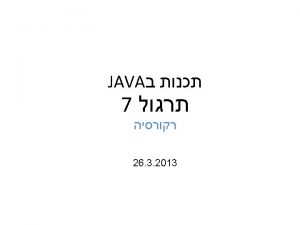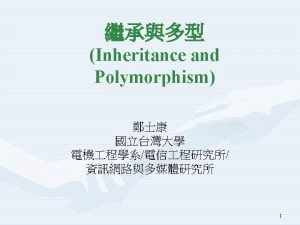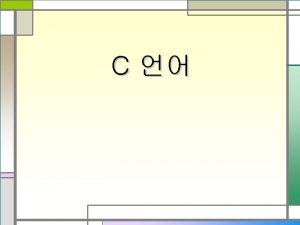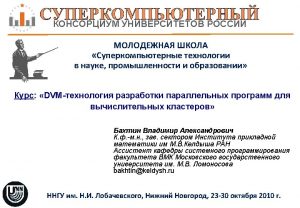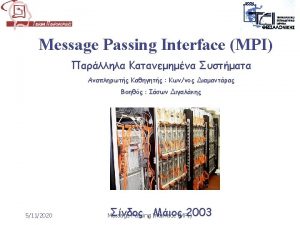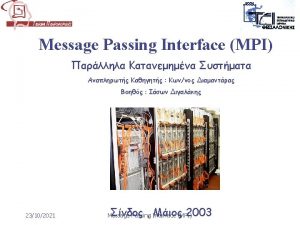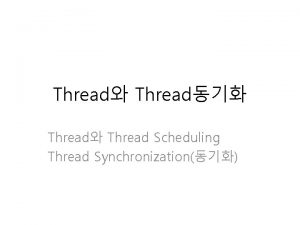thread 1 int mainint argc char argv 2





![建立和等待thread 1. __thread char name[100]; //前面冠上__thread字眼的都屬於thread local storage 2. __thread int thread. ID = 建立和等待thread 1. __thread char name[100]; //前面冠上__thread字眼的都屬於thread local storage 2. __thread int thread. ID =](https://slidetodoc.com/presentation_image_h/eacc969b348eb56c7c4d2f4bff09115b/image-6.jpg)







![計算pi的主程式 1. int main(int argc, char **argv) { 2. exename = argv[0]; 3. num. 計算pi的主程式 1. int main(int argc, char **argv) { 2. exename = argv[0]; 3. num.](https://slidetodoc.com/presentation_image_h/eacc969b348eb56c7c4d2f4bff09115b/image-14.jpg)




- Slides: 18





建立和等待thread 1. int main(int argc, char **argv) { 2. //取得系統中的core的數量(包含v-core) 3. num. CPU = sysconf( _SC_NPROCESSORS_ONLN ); 4. //POSIX的thread. ID定義為pthread_t,這個不見得是整數,他也可以是資料結構 5. //不要直接存取pthread_t 6. pthread_t* tid = (pthread_t*)malloc(sizeof(pthread_t) * num. CPU); 7. //列印主程式的process id和thread. ID,thread. ID是Linux專有的 8. printf("I am main funciton, my pid is %ld and my tid is %ldn", 9. (long)getpid(), gettid()); 10. printf("waiting for child threadsn"); 11. //產生執行緒,執行緒的起始函數為thread(自己取名字),可以傳給他一個64/32位元的參數 12. for (long i=0; i< num. CPU; i++) 13. pthread_create(&tid[i], NULL, (void *) thread, (void*)i); 14. //等待執行緒執行結束,請特別注意,任意二個thread可以等待對方,不一定要產生的執行緒去等 15. for (int i=0; i< num. CPU; i++) 16. pthread_join(tid[i], NULL); 17. printf("all threads finish their workn"); – 羅習五 18. 中正大學 } 創作共用-姓名 標示-非商業性-相同方式分享 CC-BY-NC-SA 5
![建立和等待thread 1 thread char name100 前面冠上thread字眼的都屬於thread local storage 2 thread int thread ID 建立和等待thread 1. __thread char name[100]; //前面冠上__thread字眼的都屬於thread local storage 2. __thread int thread. ID =](https://slidetodoc.com/presentation_image_h/eacc969b348eb56c7c4d2f4bff09115b/image-6.jpg)
建立和等待thread 1. __thread char name[100]; //前面冠上__thread字眼的都屬於thread local storage 2. __thread int thread. ID = -1; 3. void thread(void *given. Name) { 4. int given. ID = (intptr_t)given. Name; //小技巧,指標(64 b)轉整數(32 b)要用(intptr_t)才不會有警告 5. thread. ID = gettid(); //設定值給TLS中的thread. ID 6. printf("tthread���� %02 d is here. n", given. ID); 7. //印出pid和tid,注意,thread. ID雖然是global變數,但因為它屬於TLS,因此每個thread所存取的thread. ID是不一樣的 8. printf("tmy pid is %ld and my tid is %ldn", (long)getpid(), thread. ID); 9. sprintf(name, "���� ###%02 d###", given. ID); 10. sleep(1); 11. //同樣的name也屬於TLS 12. printf("tmy name is %sn", name); 13. } 中正大學 – 羅習五 創作共用-姓名 標示-非商業性-相同方式分享 CC-BY-NC-SA 6

I am main funciton, my pid is 73691 and my tid is 73691 waiting for child threads thread���� 00 is here. my pid is 73691 and my tid is 73692 thread���� 02 is here. my pid is 73691 and my tid is 73694 //省略一些輸出 my name is ���� ###13### my name is ���� ###06### my name is ���� ###04### all threads finish their work 中正大學 – 羅習五 創作共用-姓名 標示-非商業性-相同方式分享 CC-BY-NC-SA 7




蒙特卡羅法(飛鏢逼近) 「積分」的時候可以使用這個方法 https: //zh. wikipedia. org/wiki/%E 8%92%99%E 5%9 C%B 0%E 5% 8 D%A 1%E 7%BE%85%E 6%96%B 9%E 6%B 3%95 https: //zh. wikipedia. org/wiki/%E 5%9 C%86%E 7%9 A%84%E 9% 9 D%A 2%E 7%AF 中正大學 – 羅習五 創作共用-姓名 標示-非商業性-相同方式分享 CC-BY-NC-SA 11

計算pi的執行緒 1. 2. 3. 4. 5. 6. 7. 8. 9. 10. 11. 12. 13. 14. 15. volatile long score[100]; //注意,我使用了「volatile」 void thread(void *given. Name) { int id = (intptr_t)given. Name; struct drand 48_data r_data; double x, y, dist; //底下這一行是除錯用,我要確認每個thread的reandom stream是完全不同的 srand 48_r((long)given. Name, &r_data); for (int i=0; i< loop. Count; i++) { drand 48_r(&r_data, &x); drand 48_r(&r_data, &y); dist = sqrt(x*x + y*y); if (dist < 1) score[id]++; } } 中正大學 – 羅習五 創作共用-姓名 標示-非商業性-相同方式分享 CC-BY-NC-SA 12

volatile的意義 Memory-mapped peripheral registers Global variables modified by an interrupt service routine Global variables accessed by multiple tasks within a multithreaded application 如果沒有使用「volatile」這個變數,編譯器基於某些原因,最佳化時可 能會認為這個變數接下來沒有用到,就沒有產生對應的程式碼 volatile可以告訴編譯器,計算出來的值最後一定要更新到變數中 中正大學 – 羅習五 https: //embeddedgurus. com/stack-overflow/2009/12/how創作共用-姓名 to-use-cs-volatile-keyword/ 標示-非商業性-相同方式分享 13 CC-BY-NC-SA
![計算pi的主程式 1 int mainint argc char argv 2 exename argv0 3 num 計算pi的主程式 1. int main(int argc, char **argv) { 2. exename = argv[0]; 3. num.](https://slidetodoc.com/presentation_image_h/eacc969b348eb56c7c4d2f4bff09115b/image-14.jpg)
計算pi的主程式 1. int main(int argc, char **argv) { 2. exename = argv[0]; 3. num. CPU = sysconf( _SC_NPROCESSORS_ONLN ); 4. pthread_t* tid = (pthread_t*)malloc(sizeof(pthread_t) * num. CPU); 5. for (long i=0; i< num. CPU; i++) 6. pthread_create(&tid[i], NULL, (void *) thread, (void*)i); 7. for (int i=0; i< num. CPU; i++) 8. pthread_join(tid[i], NULL); 9. long total=0; 10. for (int i=0; i< num. CPU; i++) { 11. total += score[i]; 12. } 13. //這一行讓我知道飛鏢射中幾次,除錯用 14. printf("%ldn", total); 15. printf("pi = %fn", ((double)total)/(loop. Count*num. CPU)*4); 16. } 中正大學 – 羅習五 創作共用-姓名 標示-非商業性-相同方式分享 CC-BY-NC-SA 14

. /pi-random 0. 170828, 0. 041630, 0. 912433, 0. 783235, 0. 654037, 0. 395642, 0. 524840, 0. 266444, 0. 137247, 0. 008049, 0. 878851, 0. 749653, 0. 620456, 0. 491258, 0. 362060, 0. 232863, 1256644909 pi = 3. 141612 time. /pi-random 0. 170828, 0. 912433, 0. 041630, 0. 783235, 0. 654037, 0. 524840, 0. 395642, 0. 266444, 0. 137247, 0. 008049, 0. 878851, 0. 749653, 0. 620456, 0. 491258, 0. 362060, 0. 232863, 1256644909 pi = 3. 141612. /pi-random 155. 62 s user 0. 08 s system 1570% cpu 9. 914 total 使用time量測時間,發現pi總共執行了155. 62的「CPU秒」,因為共有16核心,因此換算成「人 間秒」為 9. 73秒,系統使用率為 1590%,因為 16個處理器,因此「百分比使用率為」99. 3% 中正大學 – 羅習五 創作共用-姓名 標示-非商業性-相同方式分享 CC-BY-NC-SA 15



 Int main int argc char argv
Int main int argc char argv Include
Include Glutmain
Glutmain Int sum(int a int n) int sum=0 i
Int sum(int a int n) int sum=0 i Char argv
Char argv Char argv
Char argv Public int divide(int a int b)
Public int divide(int a int b) Int max(int x int y)
Int max(int x int y) Interface calculator public int add class test
Interface calculator public int add class test Public void drawsquare(int x, int y, int len)
Public void drawsquare(int x, int y, int len) Const char *s
Const char *s Const char * vs char * const
Const char * vs char * const Short 크기
Short 크기 Long char
Long char Int char float
Int char float Int (*)(bool, char)
Int (*)(bool, char) Const int arduino adalah
Const int arduino adalah Char int float
Char int float Short 자료형 크기
Short 자료형 크기






